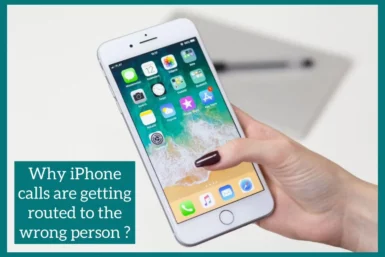Are you having trouble with iPhone calls getting routed to the wrong person? It could be awkward and frustrating, but we have got you covered.
This article will examine why this occurs and provide straightforward solutions for ensuring your calls are always routed to the appropriate person.
Why are Calls Getting Routed to The Wrong Person?
The key to effectively resolving the issue and maintaining proper call connections on your iPhone is to identify the root cause of call routing errors.
The following are the most common issues you should consider.
1. Technical Errors
The call routing procedure can be affected by software defects, code mistakes, or compatibility issues that affect the iPhone.
These mistakes could result in the device misunderstanding or handling the routing instructions, placing calls in the wrong hands.
2. Human Errors
When voice-activated commands are given, users may accidentally cause call routing issues by giving the wrong contact information, having duplicate contacts in their contact list, or pronouncing names incorrectly.
Unintended recipients may receive calls due to human error during call handling.
3. Systematic Problems in the Telecommunications Infrastructure
Problems with the carrier infrastructure and the larger telecommunications network may also be involved.
Calls may be misdirected due to network failures, call-switching mistakes, or issues with the Caller ID databases.
4. Caller ID Spoofing
Scammers frequently use caller ID spoofing to pretend to be real phone numbers, causing your iPhone to unintentionally redirect calls to the wrong recipient.
This false strategy may lead to calls being misrouted and possible privacy problems.
5. Third-Party Apps and Call Forwarding
The wrong individual may get calls due to faults in routing introduced by third-party apps or settings that are installed.
Can Someone Divert Your Calls without You Knowing?
Yes, someone can redirect your calls without your knowledge. Call diversion, often called forwarding, enables incoming calls to be forwarded to another phone number, such as voicemail or another person’s phone.
Call diversion may happen in the following circumstances without your knowledge:
Unauthorized Access to Phone Settings
Your calls could be forwarded without your knowledge if someone gains unauthorized access to your iPhone without your permission and changes the call forwarding settings.
This could happen if your phone is left unattended or someone has access to your device’s passcode or login information.
Social Engineering Attacks
Using social engineering strategies, an attacker can appear as you to the customer service representatives of your mobile carrier and persuade them to enable call forwarding on your number without your knowledge.
How to Know if Someone Has Diverted Your Calls?
To determine if someone has diverted your calls, follow these steps:
1. Check Call Forwarding Settings
Go to the call settings or call forwarding settings on your mobile device to check the call forwarding settings. Look for any call forwarding rules currently in place that you did not set.
If you discover any strange call forwarding rules, it can mean that your calls have been diverted.
2. Test Call Forwarding
Call your own number from a separate phone or have a friend call you to test call forwarding. Watch to see if the call rings and someone answers it or if it goes straight to voicemail.
Your phone may be diverted if calls repeatedly go to voicemail without ringing.
3. Talk to Your Mobile Carrier
Contact the customer service department of your cell carrier and request confirmation that call forwarding has been enabled for your number.
4. Monitor Call History
Look through your call log for any odd or unexpected calls. It may be an indication of call diversion if you observe that calls are frequently diverted to strange contacts or numbers.
5. Pay Attention to Unusual Behavior
Look for any odd behavior on your phone, such as unexpected messages from your carrier, odd pop-up alerts, or unusual data consumption. These can be warning signs of unapproved call forwarding.
6. Scan for Malware
Scan your phone for malware using reliable antivirus or security software to find any potentially harmful apps or programs causing call redirection.
Practical Solution for Calls Diversion
You can significantly decrease the chance that someone would redirect your calls without your awareness by putting these workable solutions into practice and being careful in checking and securing your phone’s settings.
1. Enhance Phone Security
- To prevent unauthorized access to your phone’s settings, use a strong passcode or enable biometric authentication (fingerprint or face recognition).
- To secure your device when not in use, turn on the auto-lock feature with a brief timeout.
- Don’t disclose your login information or passcode to anyone.
2. Consistently Check Your Call Forwarding Settings
- Check your phone’s call forwarding settings regularly to ensure no unauthorized rules are in effect.
- Call-forwarding rules you didn’t create or are unfamiliar with should be disabled.
3. Keep Track of Past Calls
- Check your call history frequently for odd patterns or calls from unidentified numbers.
- Any unusual or recurring instances of calls being diverted should be investigated.
4. Make Carrier Security Features Available
- Check with your mobile carrier for details about available security options, such as two-factor authentication or PIN protection for call forwarding modifications.
- Use the extra security precautions your carrier recommends to prevent unauthorized access to your account.
5. Contact Your Carrier
- Contact the customer service department of your mobile carrier and ask them to check the call forwarding status for your number if you suspect call diversion.
- Any questionable activity should be reported to them, and you should also ask for their help in fixing the problem.
Conclusion
In conclusion, the prevention of call diversion requires awareness and effort. You can protect your privacy and ensure that your calls continue to go to the intended receiver by regularly monitoring call forwarding settings, employing strong phone security, and remaining aware of potential dangers. Stay alert and safe!

